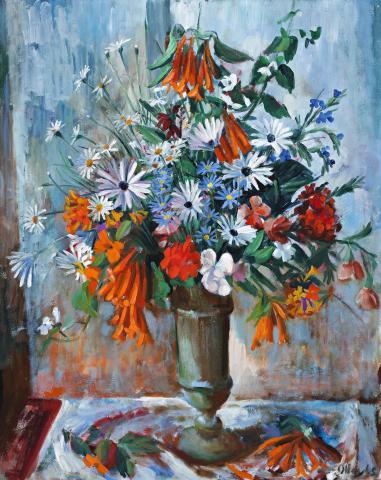WINTER FLOWERS, 1965
MARGARET OLLEY
oil on composition board
75.0 x 60.0 cm
signed and dated lower right: Olley 65
bears inscription verso: To: OSBORNE ART GALLERY / 13 LEIGH ST. / ADELAIDE / D710
Osborne Art Gallery, Adelaide
Darlinghurst Galleries, Sydney
Private collection, Perth
Margaret Olley: recent paintings, Darlinghurst Galleries, Sydney, 21 September – 16 October 1965, cat. 19
Margaret Olley’s Winter Flowers, 1965 comes from a richly fertile period in her career. Following clinical treatment in 1959, she emerged clear-headed, confident and with a ‘strong desire to get on with painting’.1 The positive results were quickly apparent and her subsequent exhibition at the Macquarie Galleries in Sydney in 1961 was met with public and critical acclaim. She also garnered a slew of notable prizes between 1962 and 1965, most notably the Redcliffe Prize (twice), the Perth Helena Rubinstein Portrait Award, and the 1965 Bendigo Art Prize with Summer Flowers, the larger companion piece to the painting on offer here. Over the next few years, her solo exhibitions were anchored around still lives which served as a stable motif through which she could progress her technique unswayed by the heady winds of late-Modernism then swirling through the art world.
One of her early champions was the artist and critic James Gleeson who wrote that ‘what distinguishes Margaret Olley’s flower studies from those of most of her contemporaries is her approach, which might best be described as symphonic’.2 Like the Italian painter Morandi (one of her heroes), Olley accumulated a vast collection of objects during her peripatetic life, each imbued with a story or individual memory. Constantly arranged and re-arranged, as well as augmented by flowers, fruits and vegetables, these objects became Olley’s subject matter, in time almost as familiar to viewers of her work as to the artist herself. The grey-green vase in Winter Flowers, for example, also appears in related paintings such as Still Life with Oranges, 1964, Pink Datura, 1966, and Floral Still Life (Tiger Lilies), 1969, with the first two also featuring the same setting of the cropped edge of a table with a crumpled cloth on top.
Olley worked on multiple paintings at the same time, noting that ‘by only doing a small part of the painting then putting it aside for another, I’m maintaining the all-over look of it … getting it right in terms of the whole; that is, I am concerned with both aspects, the particular and the general, simultaneously’.3 Although Olley claimed she was not a botanical artist per se, Winter Flowers clearly features snowcap daisies, orange honeysuckles and Chinese lanterns, all depicted with an attention to detail that enables their easy identification.4 As these blooms appear in the colder months along most of the east coast, it is uncertain whether this work was painted in the Sydney studio of her close friend David Strachan, or at Farndon, the family home in Brisbane, as she was constantly moving between the two. A tantalising suggestion that it was the latter is found in a photo of the artist painting a similar still life in 1966 at Farndon surrounded by the familiar clutter of objects and blooms, all awaiting their turn to be scrutinised and transformed into their own artistic composition.
1. Pearce, B., Margaret Olley 1923-2011, The Beagle Press, Sydney, 2012, p. 238
2. Gleeson, J., ‘Introduction’, Margaret Olley, Johnstone Gallery, Brisbane, 1964
3. Pearce, B., op cit., p. 241
4. The author thanks David Shannon for assistance in the flowers’ identification.
ANDREW GAYNOR
